TRANSLATION PROCEDURES & STRATEGIES Lecture 4 While translation

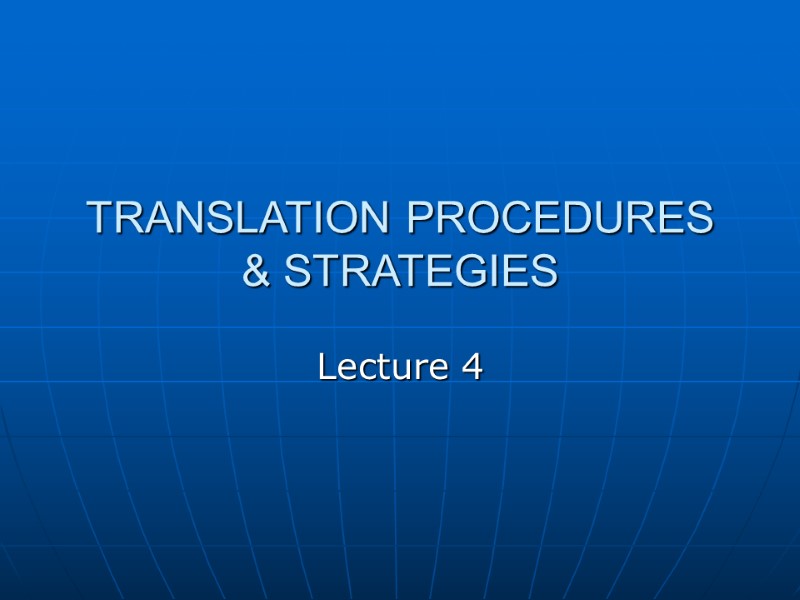
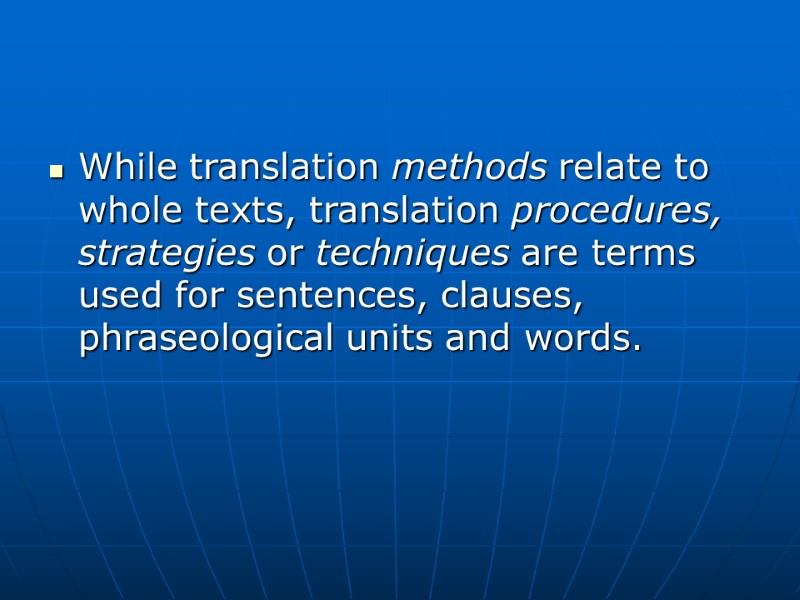
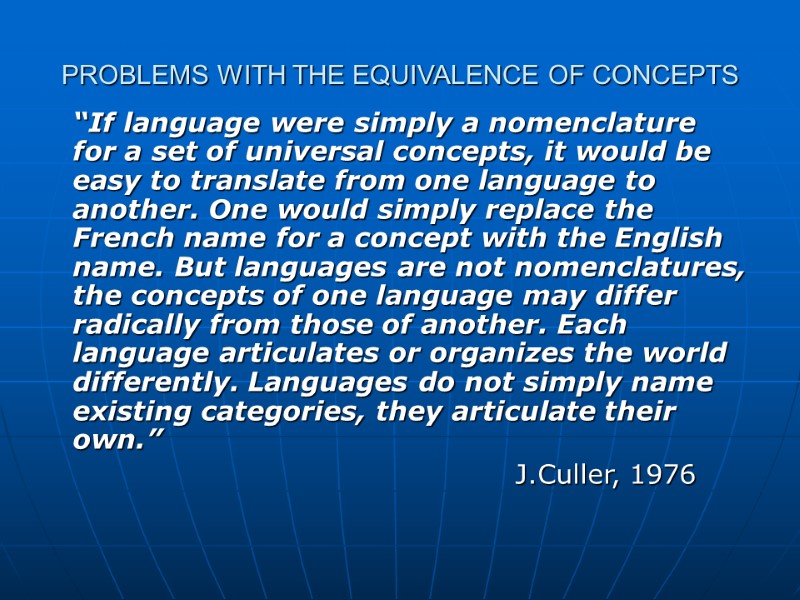
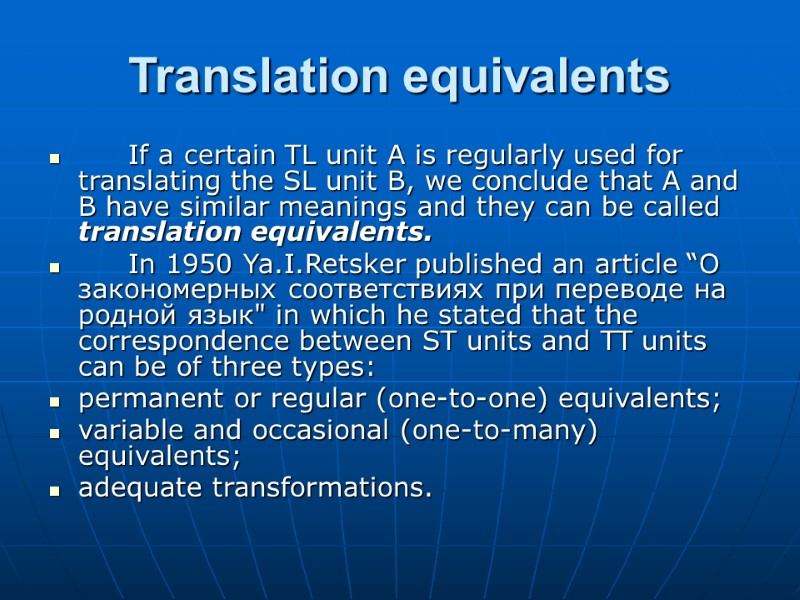
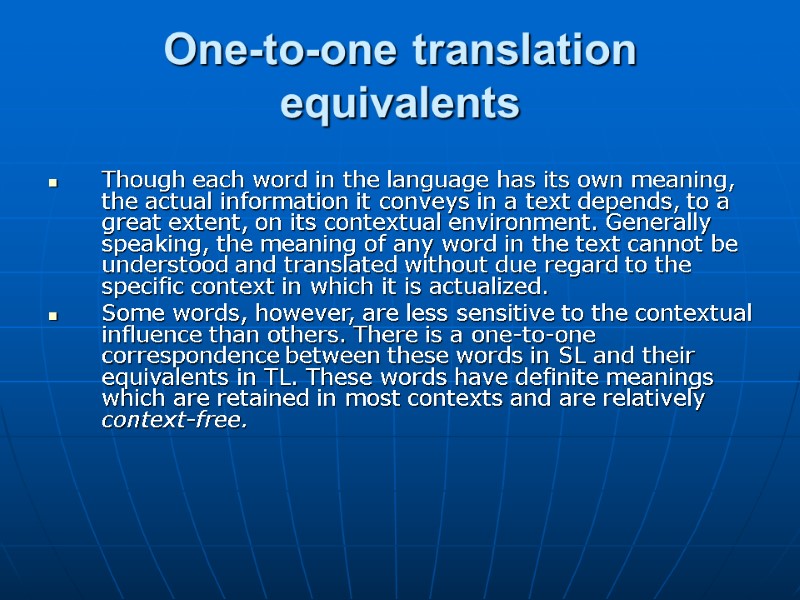
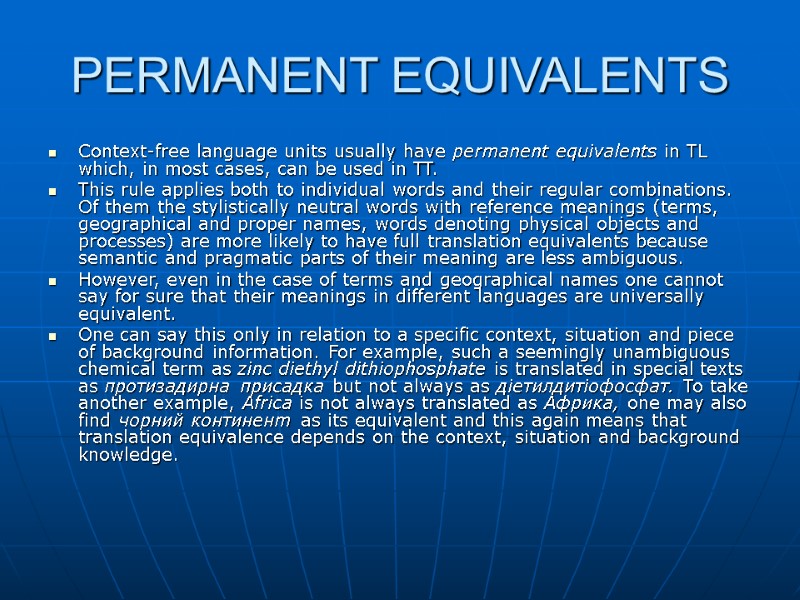
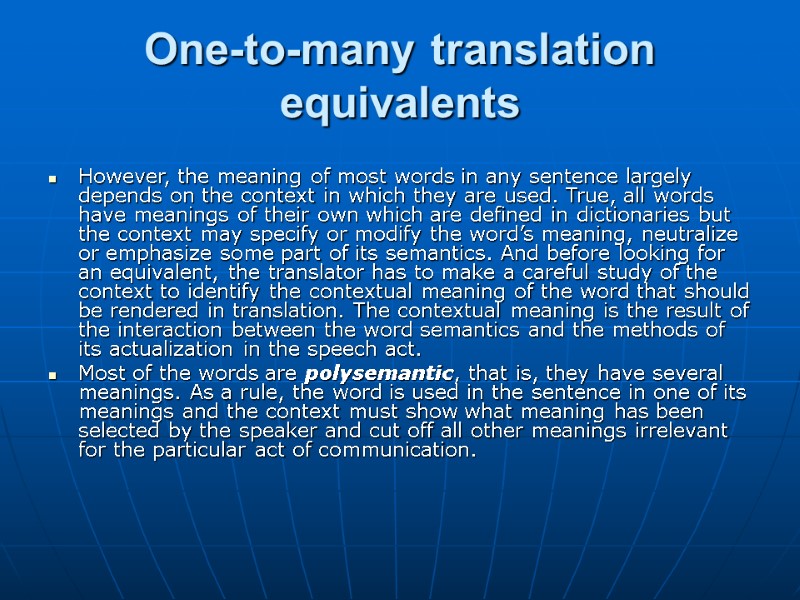

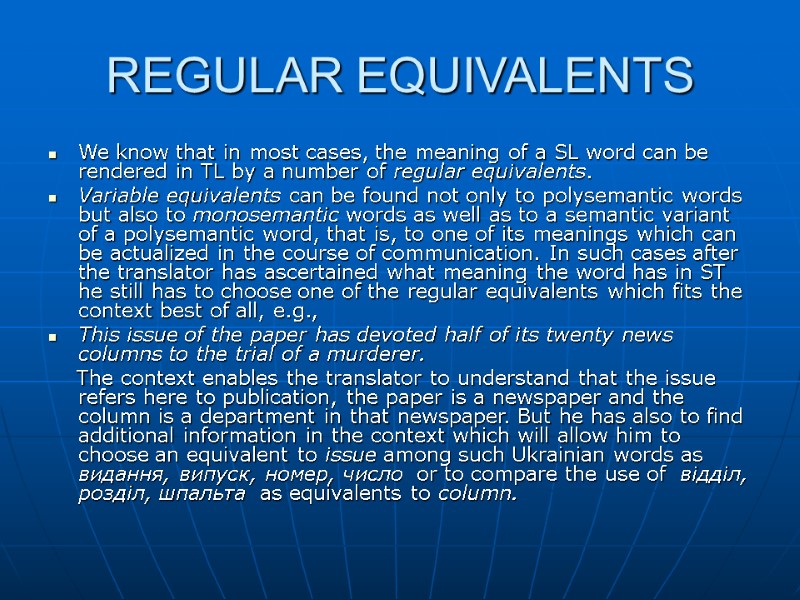
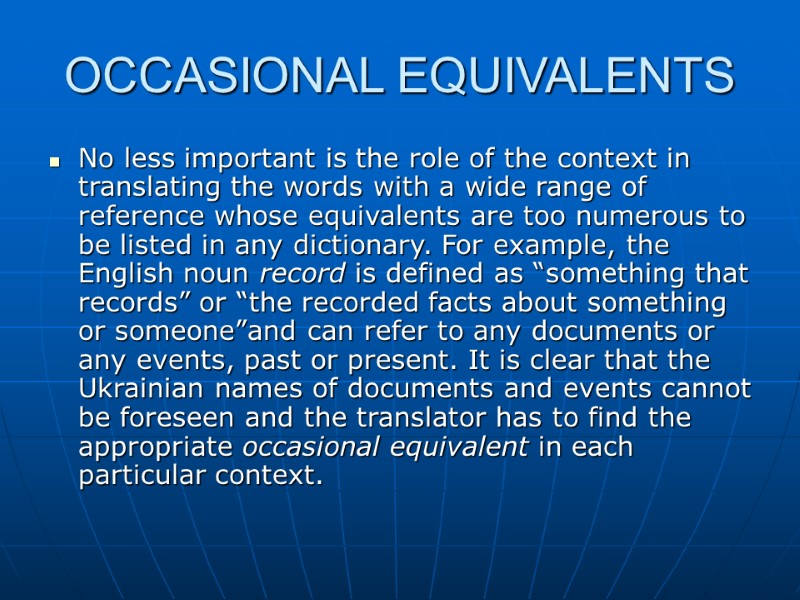
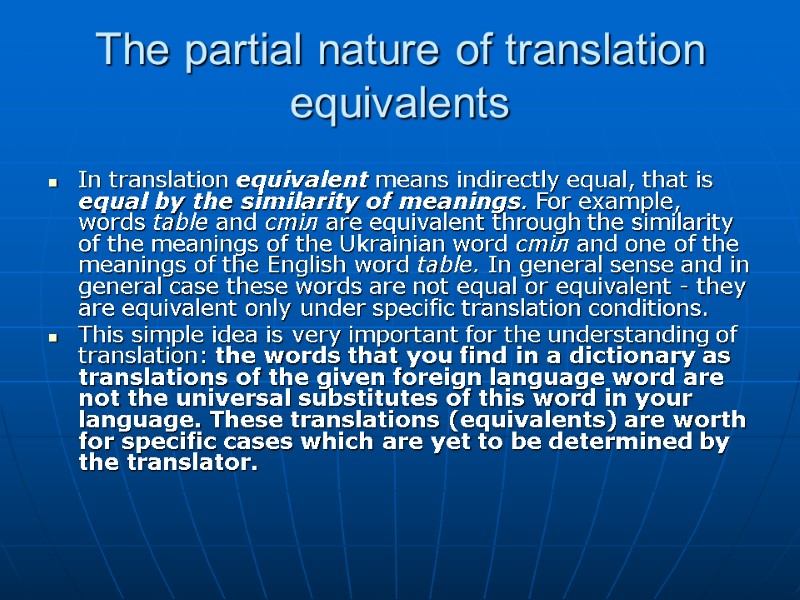
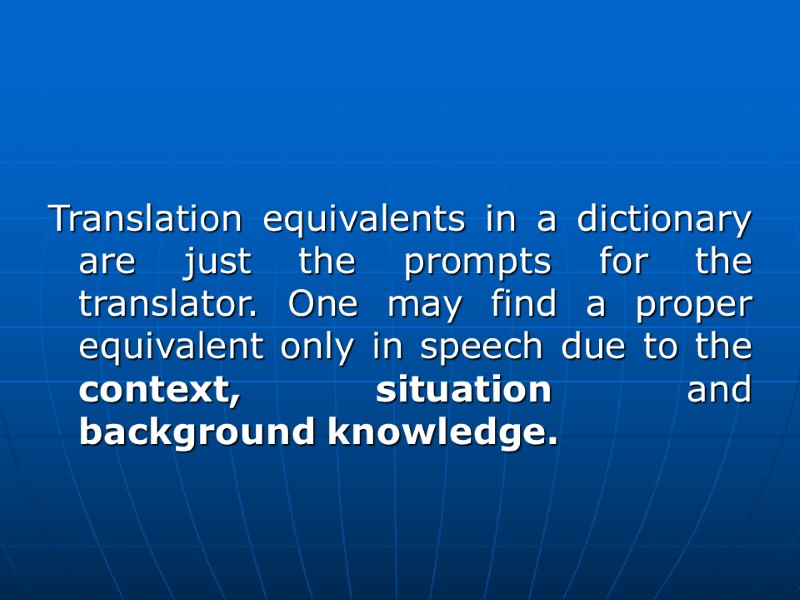
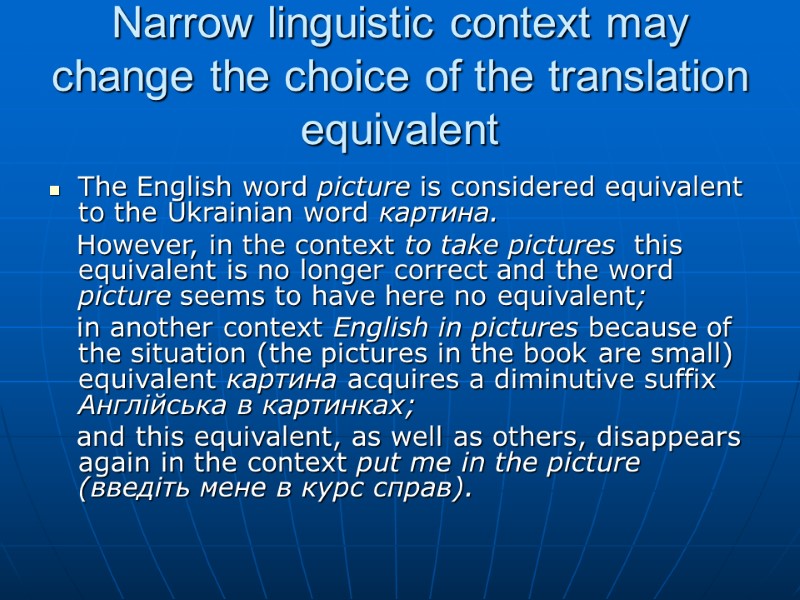
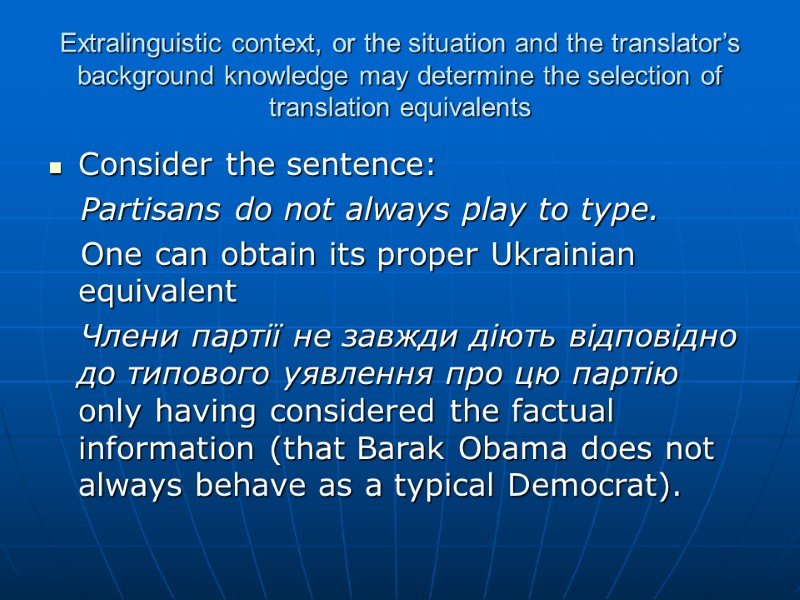
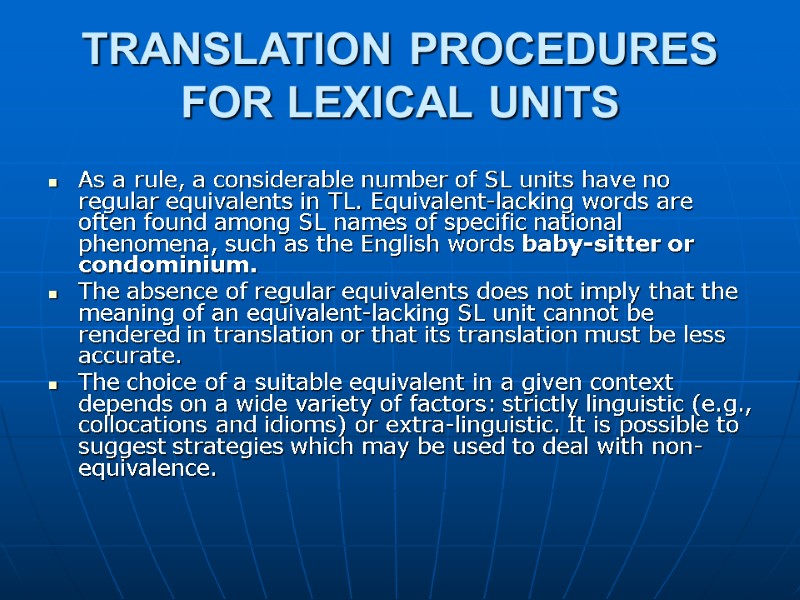
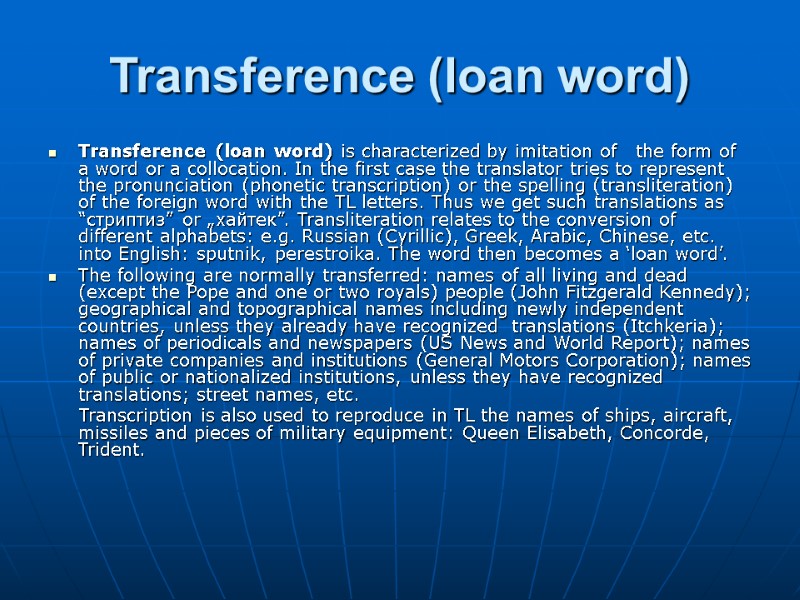
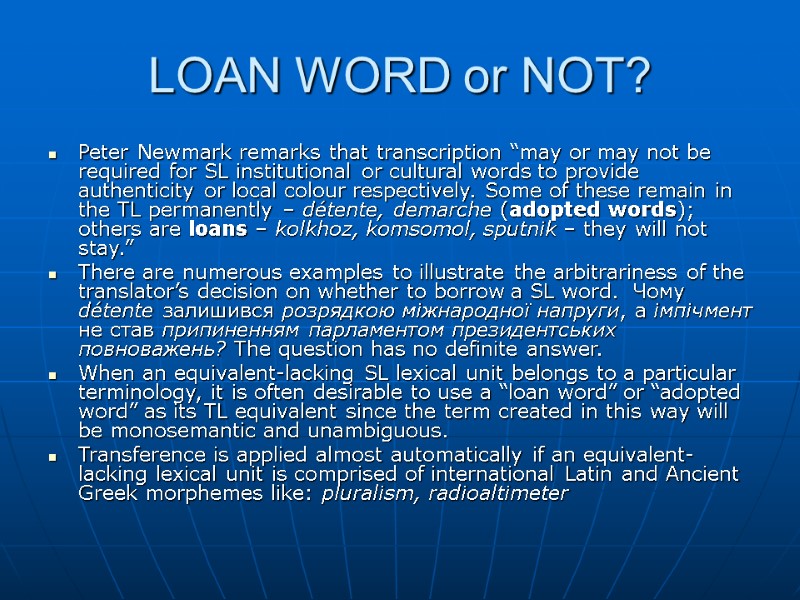
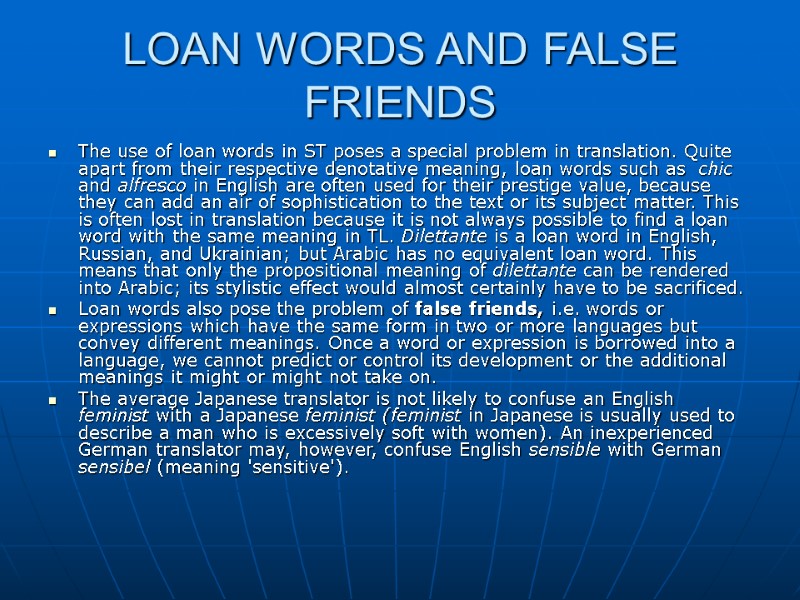
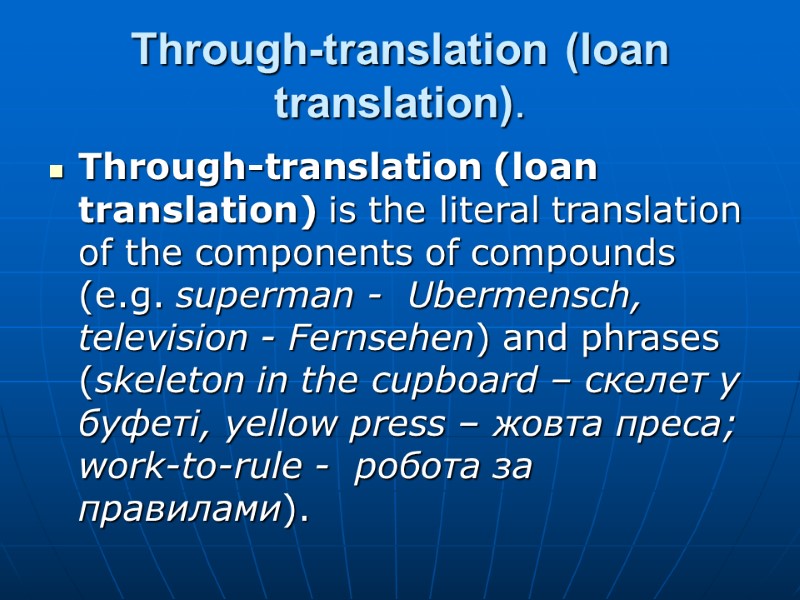
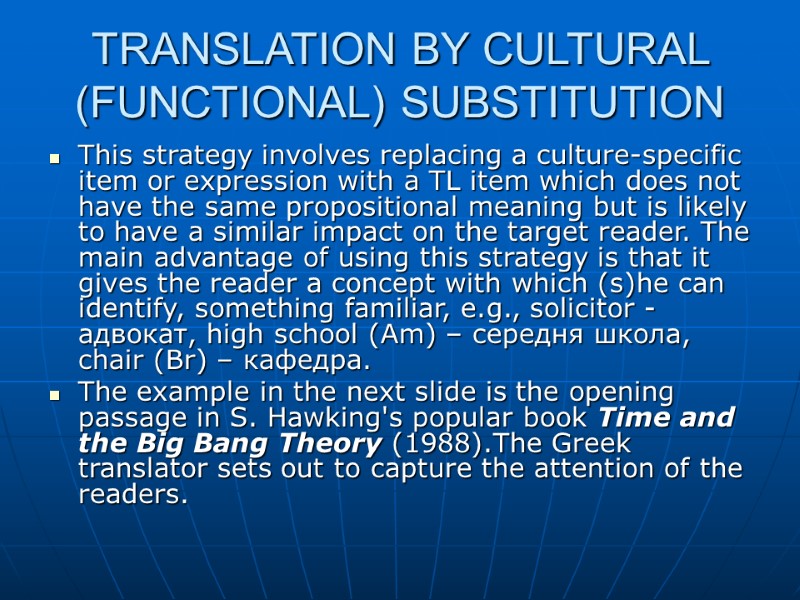
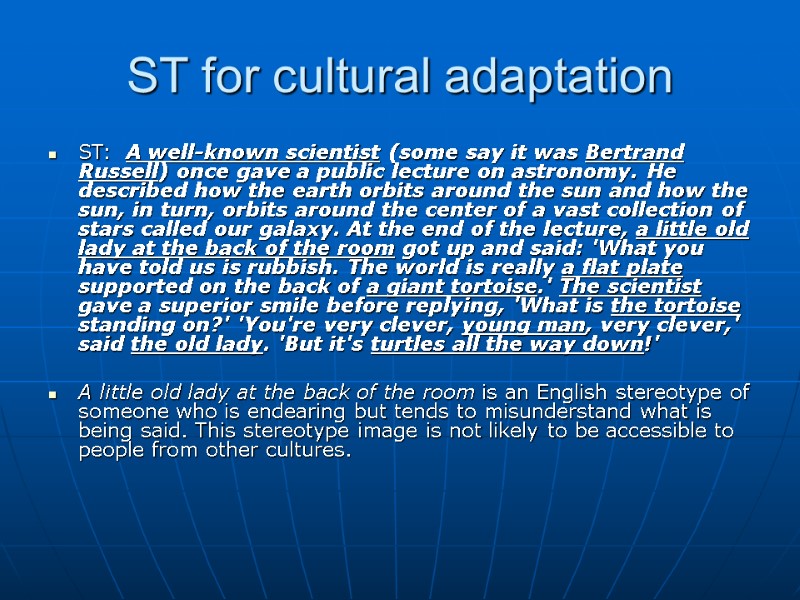
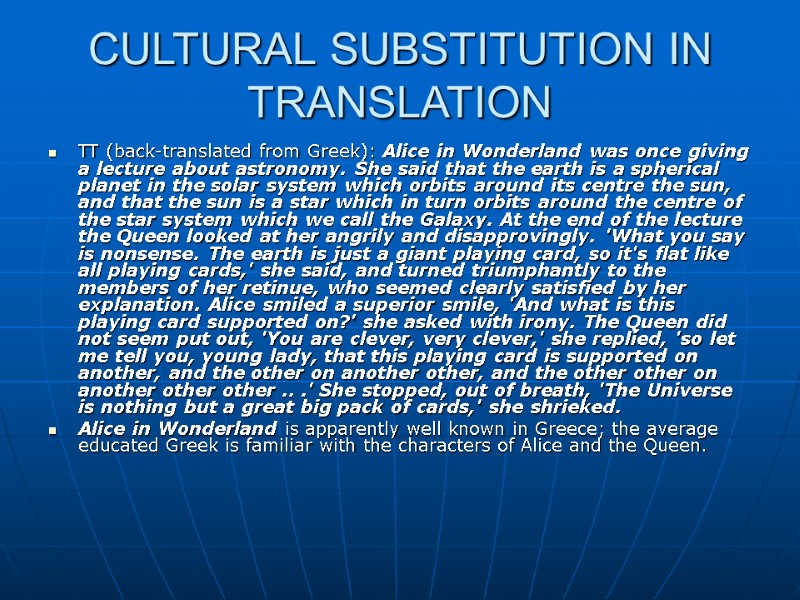
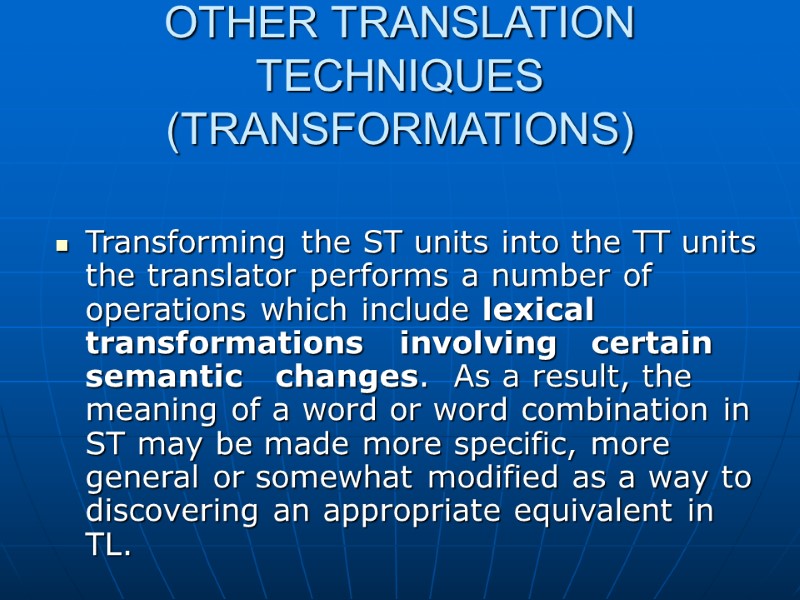
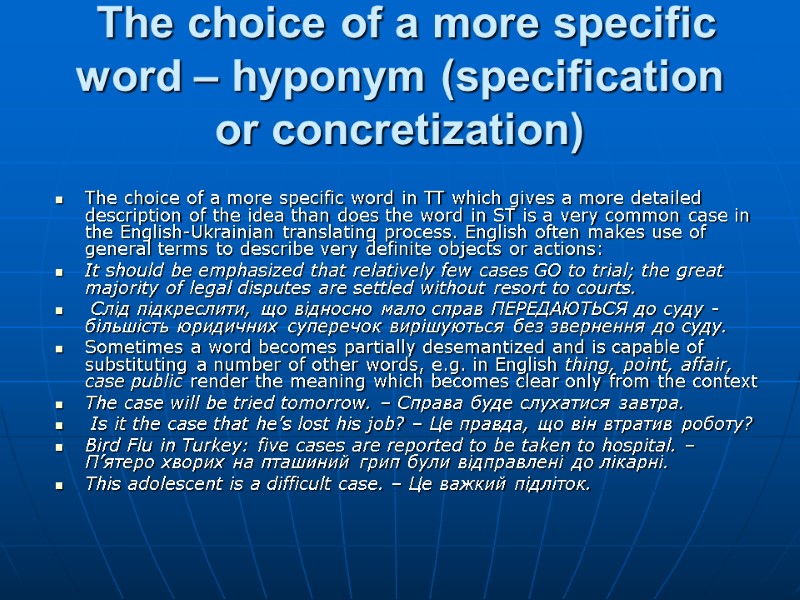
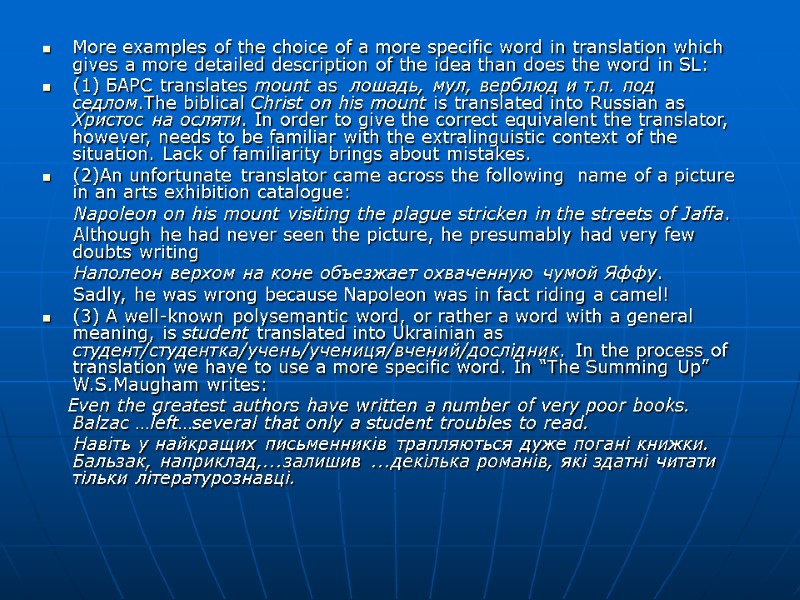
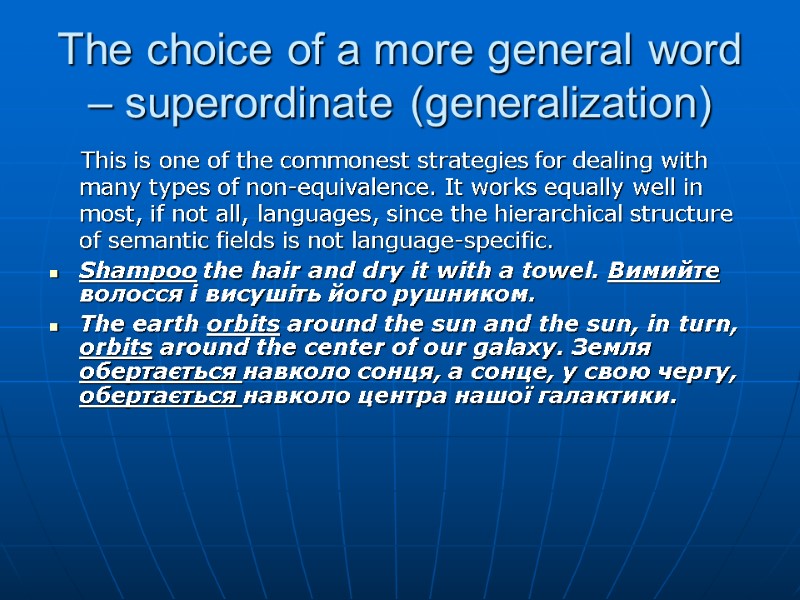
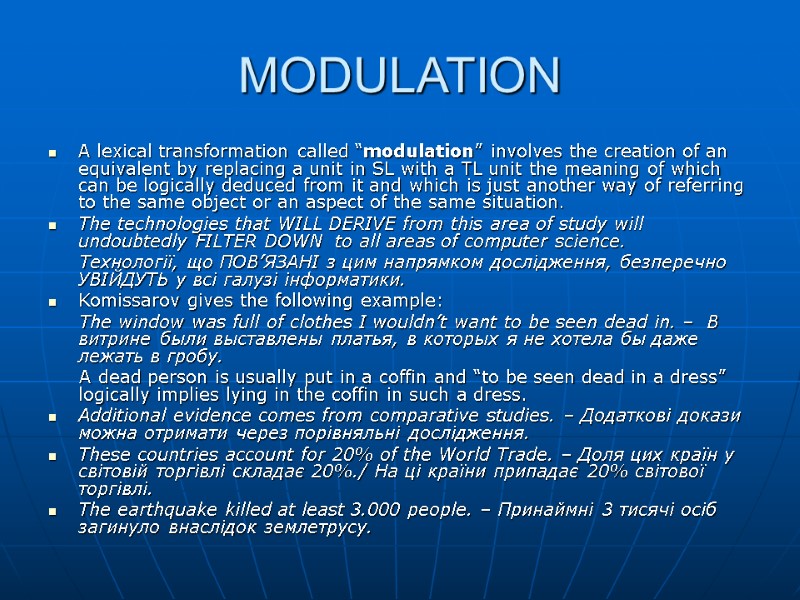
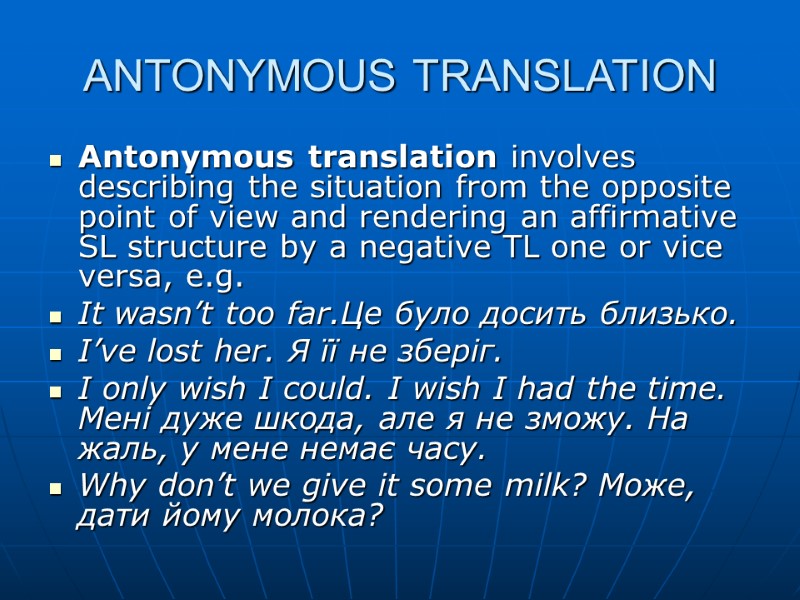
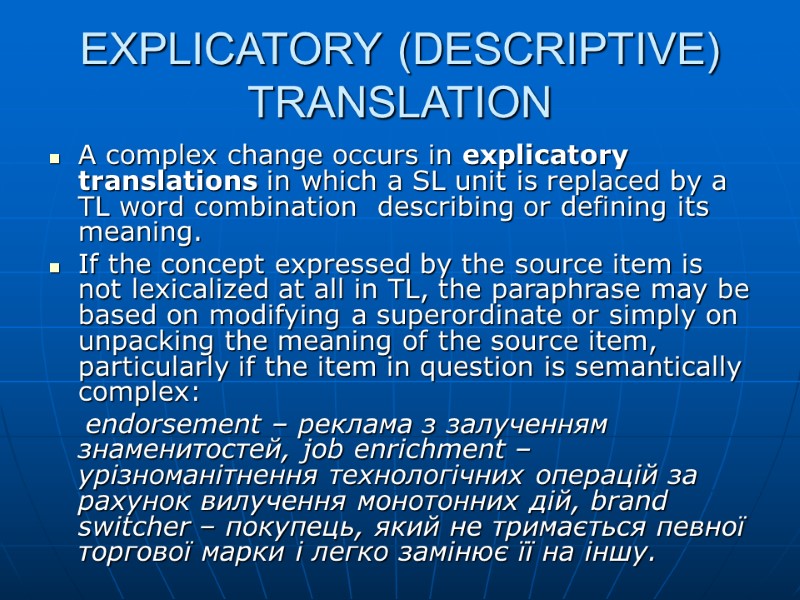
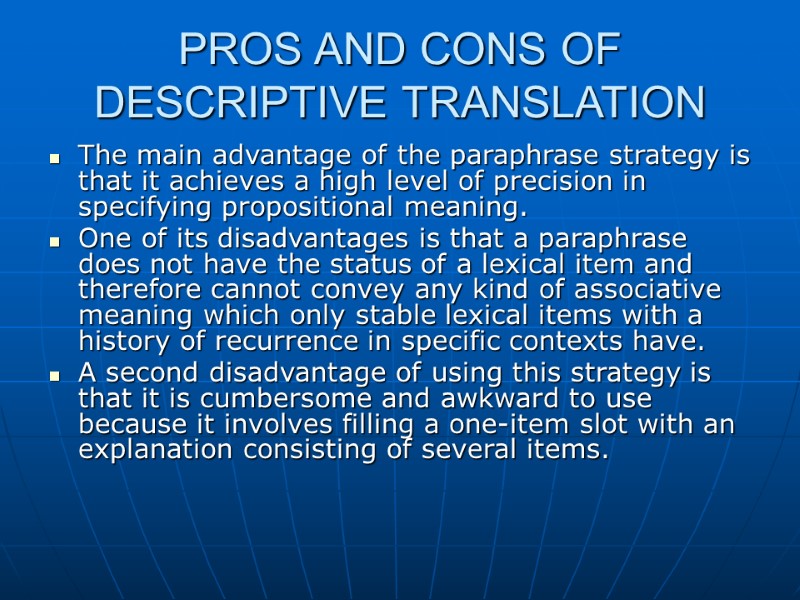
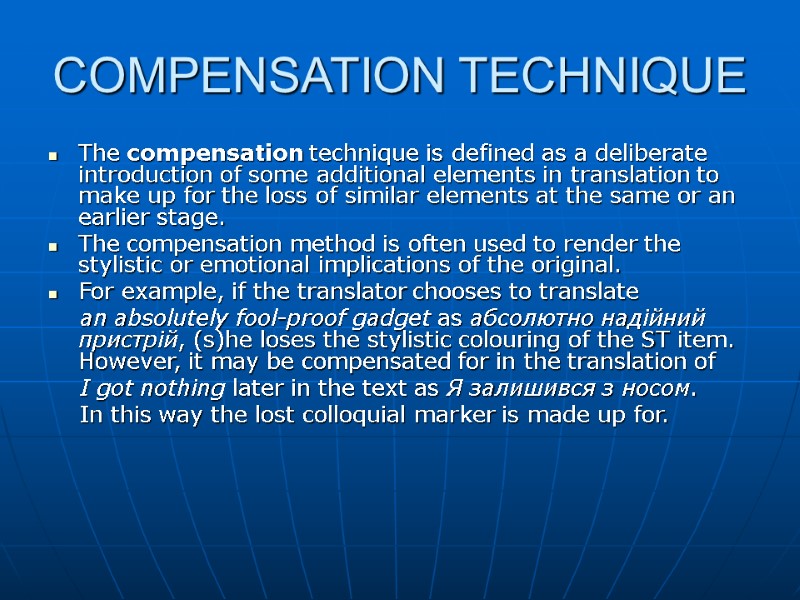
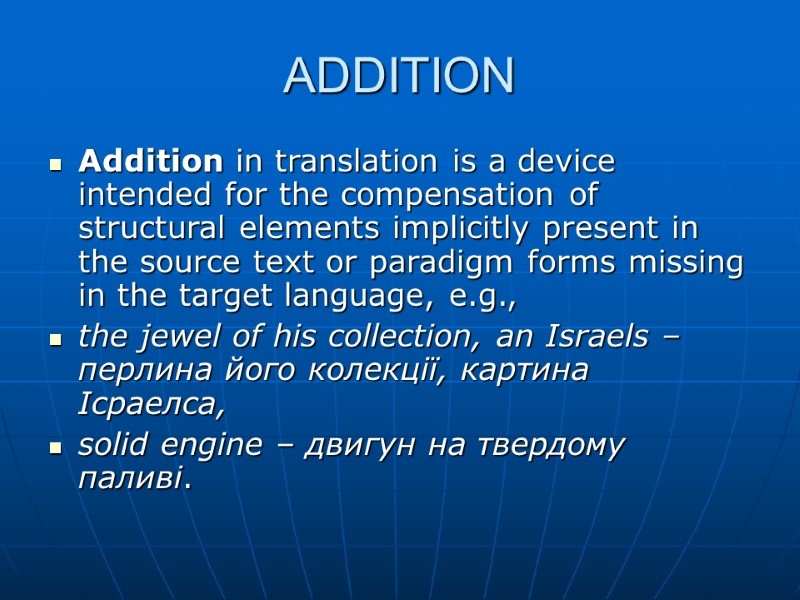
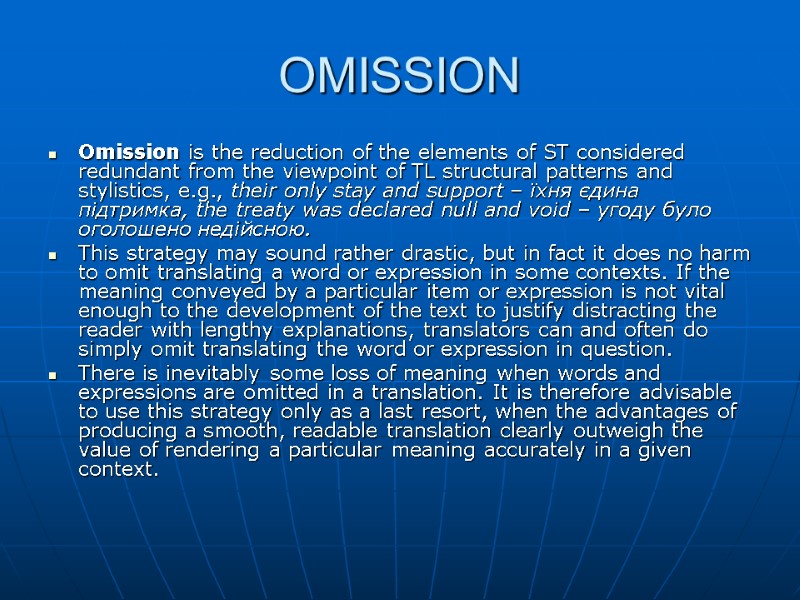
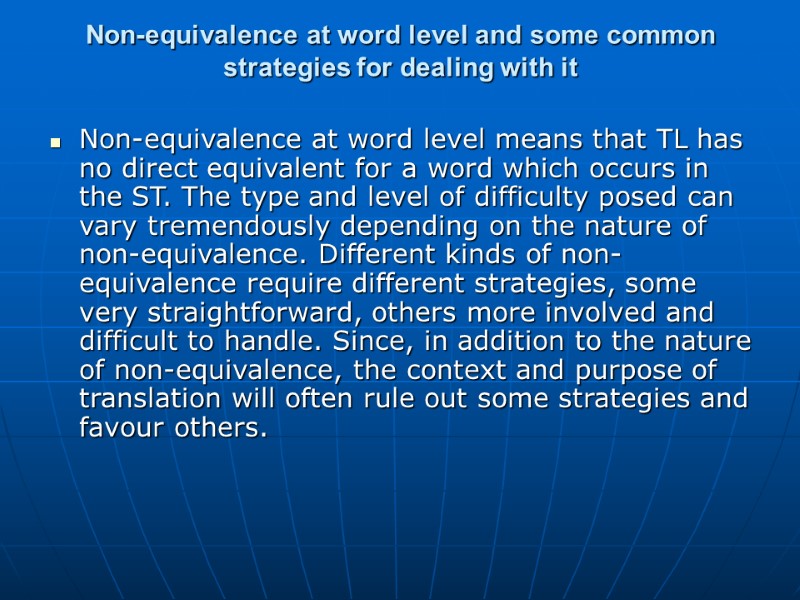
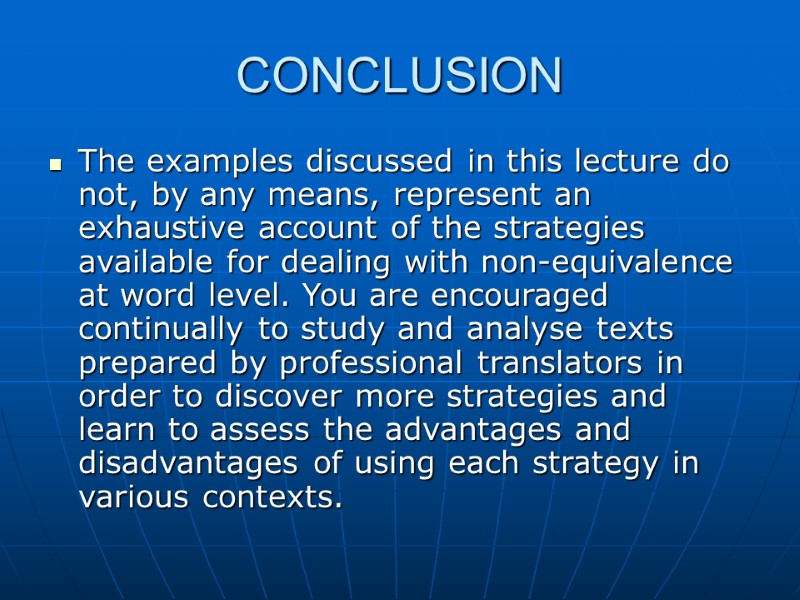
14828-translation_procedures_-_lecture_4.ppt
- Количество слайдов: 35
 TRANSLATION PROCEDURES & STRATEGIES Lecture 4
TRANSLATION PROCEDURES & STRATEGIES Lecture 4
 While translation methods relate to whole texts, translation procedures, strategies or techniques are terms used for sentences, clauses, phraseological units and words.
While translation methods relate to whole texts, translation procedures, strategies or techniques are terms used for sentences, clauses, phraseological units and words.
 PROBLEMS WITH THE EQUIVALENCE OF CONCEPTS “If language were simply a nomenclature for a set of universal concepts, it would be easy to translate from one language to another. One would simply replace the French name for a concept with the English name. But languages are not nomenclatures, the concepts of one language may differ radically from those of another. Each language articulates or organizes the world differently. Languages do not simply name existing categories, they articulate their own.” J.Culler, 1976
PROBLEMS WITH THE EQUIVALENCE OF CONCEPTS “If language were simply a nomenclature for a set of universal concepts, it would be easy to translate from one language to another. One would simply replace the French name for a concept with the English name. But languages are not nomenclatures, the concepts of one language may differ radically from those of another. Each language articulates or organizes the world differently. Languages do not simply name existing categories, they articulate their own.” J.Culler, 1976
 Translation equivalents If a certain TL unit A is regularly used for translating the SL unit B, we conclude that A and B have similar meanings and they can be called translation equivalents. In 1950 Ya.I.Retsker published an article “О закономерных соответствиях при переводе на родной язык" in which he stated that the correspondence between ST units and TT units can be of three types: permanent or regular (one-to-one) equivalents; variable and occasional (one-to-many) equivalents; adequate transformations.
Translation equivalents If a certain TL unit A is regularly used for translating the SL unit B, we conclude that A and B have similar meanings and they can be called translation equivalents. In 1950 Ya.I.Retsker published an article “О закономерных соответствиях при переводе на родной язык" in which he stated that the correspondence between ST units and TT units can be of three types: permanent or regular (one-to-one) equivalents; variable and occasional (one-to-many) equivalents; adequate transformations.
 One-to-one translation equivalents Though each word in the language has its own meaning, the actual information it conveys in a text depends, to a great extent, on its contextual environment. Generally speaking, the meaning of any word in the text cannot be understood and translated without due regard to the specific context in which it is actualized. Some words, however, are less sensitive to the contextual influence than others. There is a one-to-one correspondence between these words in SL and their equivalents in TL. These words have definite meanings which are retained in most contexts and are relatively context-free.
One-to-one translation equivalents Though each word in the language has its own meaning, the actual information it conveys in a text depends, to a great extent, on its contextual environment. Generally speaking, the meaning of any word in the text cannot be understood and translated without due regard to the specific context in which it is actualized. Some words, however, are less sensitive to the contextual influence than others. There is a one-to-one correspondence between these words in SL and their equivalents in TL. These words have definite meanings which are retained in most contexts and are relatively context-free.
 PERMANENT EQUIVALENTS Context-free language units usually have permanent equivalents in TL which, in most cases, can be used in TT. This rule applies both to individual words and their regular combinations. Of them the stylistically neutral words with reference meanings (terms, geographical and proper names, words denoting physical objects and processes) are more likely to have full translation equivalents because semantic and pragmatic parts of their meaning are less ambiguous. However, even in the case of terms and geographical names one cannot say for sure that their meanings in different languages are universally equivalent. One can say this only in relation to a specific context, situation and piece of background information. For example, such a seemingly unambiguous chemical term as zinc diethyl dithiophosphate is translated in special texts as протизадирна присадка but not always as діетилдитіофосфат. To take another example, Africa is not always translated as Aфрикa, one may also find чорний континенm as its equivalent and this again means that translation equivalence depends on the context, situation and background knowledge.
PERMANENT EQUIVALENTS Context-free language units usually have permanent equivalents in TL which, in most cases, can be used in TT. This rule applies both to individual words and their regular combinations. Of them the stylistically neutral words with reference meanings (terms, geographical and proper names, words denoting physical objects and processes) are more likely to have full translation equivalents because semantic and pragmatic parts of their meaning are less ambiguous. However, even in the case of terms and geographical names one cannot say for sure that their meanings in different languages are universally equivalent. One can say this only in relation to a specific context, situation and piece of background information. For example, such a seemingly unambiguous chemical term as zinc diethyl dithiophosphate is translated in special texts as протизадирна присадка but not always as діетилдитіофосфат. To take another example, Africa is not always translated as Aфрикa, one may also find чорний континенm as its equivalent and this again means that translation equivalence depends on the context, situation and background knowledge.
 One-to-many translation equivalents However, the meaning of most words in any sentence largely depends on the context in which they are used. True, all words have meanings of their own which are defined in dictionaries but the context may specify or modify the word’s meaning, neutralize or emphasize some part of its semantics. And before looking for an equivalent, the translator has to make a careful study of the context to identify the contextual meaning of the word that should be rendered in translation. The contextual meaning is the result of the interaction between the word semantics and the methods of its actualization in the speech act. Most of the words are polysemantic, that is, they have several meanings. As a rule, the word is used in the sentence in one of its meanings and the context must show what meaning has been selected by the speaker and cut off all other meanings irrelevant for the particular act of communication.
One-to-many translation equivalents However, the meaning of most words in any sentence largely depends on the context in which they are used. True, all words have meanings of their own which are defined in dictionaries but the context may specify or modify the word’s meaning, neutralize or emphasize some part of its semantics. And before looking for an equivalent, the translator has to make a careful study of the context to identify the contextual meaning of the word that should be rendered in translation. The contextual meaning is the result of the interaction between the word semantics and the methods of its actualization in the speech act. Most of the words are polysemantic, that is, they have several meanings. As a rule, the word is used in the sentence in one of its meanings and the context must show what meaning has been selected by the speaker and cut off all other meanings irrelevant for the particular act of communication.
 CONTEXT-DEPENDENT TRANSLATION EQUIVALENTS If somebody complains that Few Europeans speak Mandarin, the context unequivocally shows that it is the Chinese language that is meant and not a Chinese imperial officer or the Chinese fruit. If the same idea is expressed in a more ambiguous way, for instance, Few Europeans know the first thing about Mandarin, the context of the sentence may fail to indicate the relevant meaning beyond any doubt but the rest of the text or the circumstances of communication will certainly do that.
CONTEXT-DEPENDENT TRANSLATION EQUIVALENTS If somebody complains that Few Europeans speak Mandarin, the context unequivocally shows that it is the Chinese language that is meant and not a Chinese imperial officer or the Chinese fruit. If the same idea is expressed in a more ambiguous way, for instance, Few Europeans know the first thing about Mandarin, the context of the sentence may fail to indicate the relevant meaning beyond any doubt but the rest of the text or the circumstances of communication will certainly do that.
 REGULAR EQUIVALENTS We know that in most cases, the meaning of a SL word can be rendered in TL by a number of regular equivalents. Variable equivalents can be found not only to polysemantic words but also to monosemantic words as well as to a semantic variant of a polysemantic word, that is, to one of its meanings which can be actualized in the course of communication. In such cases after the translator has ascertained what meaning the word has in ST he still has to choose one of the regular equivalents which fits the context best of all, e.g., This issue of the paper has devoted half of its twenty news columns to the trial of a murderer. The context enables the translator to understand that the issue refers here to publication, the paper is a newspaper and the column is a department in that newspaper. But he has also to find additional information in the context which will allow him to choose an equivalent to issue among such Ukrainian words as видання, випуск, номер, число or to compare the use of відділ, розділ, шпальта as equivalents to column.
REGULAR EQUIVALENTS We know that in most cases, the meaning of a SL word can be rendered in TL by a number of regular equivalents. Variable equivalents can be found not only to polysemantic words but also to monosemantic words as well as to a semantic variant of a polysemantic word, that is, to one of its meanings which can be actualized in the course of communication. In such cases after the translator has ascertained what meaning the word has in ST he still has to choose one of the regular equivalents which fits the context best of all, e.g., This issue of the paper has devoted half of its twenty news columns to the trial of a murderer. The context enables the translator to understand that the issue refers here to publication, the paper is a newspaper and the column is a department in that newspaper. But he has also to find additional information in the context which will allow him to choose an equivalent to issue among such Ukrainian words as видання, випуск, номер, число or to compare the use of відділ, розділ, шпальта as equivalents to column.
 OCCASIONAL EQUIVALENTS No less important is the role of the context in translating the words with a wide range of reference whose equivalents are too numerous to be listed in any dictionary. For example, the English noun record is defined as “something that records” or “the recorded facts about something or someone”and can refer to any documents or any events, past or present. It is clear that the Ukrainian names of documents and events cannot be foreseen and the translator has to find the appropriate occasional equivalent in each particular context.
OCCASIONAL EQUIVALENTS No less important is the role of the context in translating the words with a wide range of reference whose equivalents are too numerous to be listed in any dictionary. For example, the English noun record is defined as “something that records” or “the recorded facts about something or someone”and can refer to any documents or any events, past or present. It is clear that the Ukrainian names of documents and events cannot be foreseen and the translator has to find the appropriate occasional equivalent in each particular context.
 The partial nature of translation equivalents In translation equivalent means indirectly equal, that is equal by the similarity of meanings. For example, words table and cmiл are equivalent through the similarity of the meanings of the Ukrainian word cmiл and one of the meanings of the English word table. In general sense and in general case these words are not equal or equivalent - they are equivalent only under specific translation conditions. This simple idea is very important for the understanding of translation: the words that you find in a dictionary as translations of the given foreign language word are not the universal substitutes of this word in your language. These translations (equivalents) are worth for specific cases which are yet to be determined by the translator.
The partial nature of translation equivalents In translation equivalent means indirectly equal, that is equal by the similarity of meanings. For example, words table and cmiл are equivalent through the similarity of the meanings of the Ukrainian word cmiл and one of the meanings of the English word table. In general sense and in general case these words are not equal or equivalent - they are equivalent only under specific translation conditions. This simple idea is very important for the understanding of translation: the words that you find in a dictionary as translations of the given foreign language word are not the universal substitutes of this word in your language. These translations (equivalents) are worth for specific cases which are yet to be determined by the translator.
 Translation equivalents in a dictionary are just the prompts for the translator. One may find a proper equivalent only in speech due to the context, situation and background knowledge.
Translation equivalents in a dictionary are just the prompts for the translator. One may find a proper equivalent only in speech due to the context, situation and background knowledge.
 Narrow linguistic context may change the choice of the translation equivalent The English word picture is considered equivalent to the Ukrainian word картина. However, in the context to take pictures this equivalent is no longer correct and the word picture seems to have here no equivalent; in another context English in pictures because of the situation (the pictures in the book are small) equivalent картина acquires a diminutive suffix Англійська в картинках; and this equivalent, as well as others, disappears again in the context put me in the picture (введіть мене в курс справ).
Narrow linguistic context may change the choice of the translation equivalent The English word picture is considered equivalent to the Ukrainian word картина. However, in the context to take pictures this equivalent is no longer correct and the word picture seems to have here no equivalent; in another context English in pictures because of the situation (the pictures in the book are small) equivalent картина acquires a diminutive suffix Англійська в картинках; and this equivalent, as well as others, disappears again in the context put me in the picture (введіть мене в курс справ).
 Extralinguistic context, or the situation and the translator’s background knowledge may determine the selection of translation equivalents Consider the sentence: Partisans do not always play to type. One can obtain its proper Ukrainian equivalent Члени партії не завжди діють відповідно до типового уявлення про цю партію only having considered the factual information (that Barak Obama does not always behave as a typical Democrat).
Extralinguistic context, or the situation and the translator’s background knowledge may determine the selection of translation equivalents Consider the sentence: Partisans do not always play to type. One can obtain its proper Ukrainian equivalent Члени партії не завжди діють відповідно до типового уявлення про цю партію only having considered the factual information (that Barak Obama does not always behave as a typical Democrat).
 TRANSLATION PROCEDURES FOR LEXICAL UNITS As a rule, a considerable number of SL units have no regular equivalents in TL. Equivalent-lacking words are often found among SL names of specific national phenomena, such as the English words baby-sitter or condominium. The absence of regular equivalents does not imply that the meaning of an equivalent-lacking SL unit cannot be rendered in translation or that its translation must be less accurate. The choice of a suitable equivalent in a given context depends on a wide variety of factors: strictly linguistic (e.g., collocations and idioms) or extra-linguistic. It is possible to suggest strategies which may be used to deal with non-equivalence.
TRANSLATION PROCEDURES FOR LEXICAL UNITS As a rule, a considerable number of SL units have no regular equivalents in TL. Equivalent-lacking words are often found among SL names of specific national phenomena, such as the English words baby-sitter or condominium. The absence of regular equivalents does not imply that the meaning of an equivalent-lacking SL unit cannot be rendered in translation or that its translation must be less accurate. The choice of a suitable equivalent in a given context depends on a wide variety of factors: strictly linguistic (e.g., collocations and idioms) or extra-linguistic. It is possible to suggest strategies which may be used to deal with non-equivalence.
 Transference (loan word) Transference (loan word) is characterized by imitation of the form of a word or a collocation. In the first case the translator tries to represent the pronunciation (phonetic transcription) or the spelling (transliteration) of the foreign word with the TL letters. Thus we get such translations as “стриптиз” or „хайтек”. Transliteration relates to the conversion of different alphabets: e.g. Russian (Cyrillic), Greek, Arabic, Chinese, etc. into English: sputnik, perestroika. The word then becomes a ‘loan word’. The following are normally transferred: names of all living and dead (except the Pope and one or two royals) people (John Fitzgerald Kennedy); geographical and topographical names including newly independent countries, unless they already have recognized translations (Itchkeria); names of periodicals and newspapers (US News and World Report); names of private companies and institutions (General Motors Corporation); names of public or nationalized institutions, unless they have recognized translations; street names, etc. Transcription is also used to reproduce in TL the names of ships, aircraft, missiles and pieces of military equipment: Queen Elisabeth, Concorde, Trident.
Transference (loan word) Transference (loan word) is characterized by imitation of the form of a word or a collocation. In the first case the translator tries to represent the pronunciation (phonetic transcription) or the spelling (transliteration) of the foreign word with the TL letters. Thus we get such translations as “стриптиз” or „хайтек”. Transliteration relates to the conversion of different alphabets: e.g. Russian (Cyrillic), Greek, Arabic, Chinese, etc. into English: sputnik, perestroika. The word then becomes a ‘loan word’. The following are normally transferred: names of all living and dead (except the Pope and one or two royals) people (John Fitzgerald Kennedy); geographical and topographical names including newly independent countries, unless they already have recognized translations (Itchkeria); names of periodicals and newspapers (US News and World Report); names of private companies and institutions (General Motors Corporation); names of public or nationalized institutions, unless they have recognized translations; street names, etc. Transcription is also used to reproduce in TL the names of ships, aircraft, missiles and pieces of military equipment: Queen Elisabeth, Concorde, Trident.
 LOAN WORD or NOT? Peter Newmark remarks that transcription “may or may not be required for SL institutional or cultural words to provide authenticity or local colour respectively. Some of these remain in the TL permanently – détente, demarche (adopted words); others are loans – kolkhoz, komsomol, sputnik – they will not stay.” There are numerous examples to illustrate the arbitrariness of the translator’s decision on whether to borrow a SL word. Чому détente залишився розрядкою міжнародної напруги, а імпічмент не став припиненням парламентом президентських повноважень? The question has no definite answer. When an equivalent-lacking SL lexical unit belongs to a particular terminology, іt is often desirable to use a “loan word” or “adopted word” as its TL equivalent since the term created in this way will be monosemantic and unambiguous. Transference is applied almost automatically if an equivalent-lacking lexical unit is comprised of international Latin and Ancient Greek morphemes like: pluralism, radioaltimeter
LOAN WORD or NOT? Peter Newmark remarks that transcription “may or may not be required for SL institutional or cultural words to provide authenticity or local colour respectively. Some of these remain in the TL permanently – détente, demarche (adopted words); others are loans – kolkhoz, komsomol, sputnik – they will not stay.” There are numerous examples to illustrate the arbitrariness of the translator’s decision on whether to borrow a SL word. Чому détente залишився розрядкою міжнародної напруги, а імпічмент не став припиненням парламентом президентських повноважень? The question has no definite answer. When an equivalent-lacking SL lexical unit belongs to a particular terminology, іt is often desirable to use a “loan word” or “adopted word” as its TL equivalent since the term created in this way will be monosemantic and unambiguous. Transference is applied almost automatically if an equivalent-lacking lexical unit is comprised of international Latin and Ancient Greek morphemes like: pluralism, radioaltimeter
 LOAN WORDS AND FALSE FRIENDS The use of loan words in ST poses a special problem in translation. Quite apart from their respective denotative meaning, loan words such as chic and alfresco in English are often used for their prestige value, because they can add an air of sophistication to the text or its subject matter. This is often lost in translation because it is not always possible to find a loan word with the same meaning in TL. Dilettante is a loan word in English, Russian, and Ukrainian; but Arabic has no equivalent loan word. This means that only the propositional meaning of dilettante can be rendered into Arabic; its stylistic effect would almost certainly have to be sacrificed. Loan words also pose the problem of false friends, i.e. words or expressions which have the same form in two or more languages but convey different meanings. Once a word or expression is borrowed into a language, we cannot predict or control its development or the additional meanings it might or might not take on. The average Japanese translator is not likely to confuse an English feminist with a Japanese feminist (feminist in Japanese is usually used to describe a man who is excessively soft with women). An inexperienced German translator may, however, confuse English sensible with German sensibel (meaning 'sensitive').
LOAN WORDS AND FALSE FRIENDS The use of loan words in ST poses a special problem in translation. Quite apart from their respective denotative meaning, loan words such as chic and alfresco in English are often used for their prestige value, because they can add an air of sophistication to the text or its subject matter. This is often lost in translation because it is not always possible to find a loan word with the same meaning in TL. Dilettante is a loan word in English, Russian, and Ukrainian; but Arabic has no equivalent loan word. This means that only the propositional meaning of dilettante can be rendered into Arabic; its stylistic effect would almost certainly have to be sacrificed. Loan words also pose the problem of false friends, i.e. words or expressions which have the same form in two or more languages but convey different meanings. Once a word or expression is borrowed into a language, we cannot predict or control its development or the additional meanings it might or might not take on. The average Japanese translator is not likely to confuse an English feminist with a Japanese feminist (feminist in Japanese is usually used to describe a man who is excessively soft with women). An inexperienced German translator may, however, confuse English sensible with German sensibel (meaning 'sensitive').
 Through-translation (loan translation). Through-translation (loan translation) is the literal translation of the components of compounds (e.g. superman - Ubermensch, television - Fernsehen) and phrases (skeleton in the cupboard – скелет у буфеті, yellow press – жовта преса; work-to-rule - робота за правилами).
Through-translation (loan translation). Through-translation (loan translation) is the literal translation of the components of compounds (e.g. superman - Ubermensch, television - Fernsehen) and phrases (skeleton in the cupboard – скелет у буфеті, yellow press – жовта преса; work-to-rule - робота за правилами).
 TRANSLATION BY CULTURAL (FUNCTIONAL) SUBSTITUTION This strategy involves replacing a culture-specific item or expression with a TL item which does not have the same propositional meaning but is likely to have a similar impact on the target reader. The main advantage of using this strategy is that it gives the reader a concept with which (s)he can identify, something familiar, e.g., solicitor - адвокат, high school (Am) – середня школа, chair (Br) – кафедра. The example in the next slide is the opening passage in S. Hawking's popular book Time and the Big Bang Theory (1988).The Greek translator sets out to capture the attention of the readers.
TRANSLATION BY CULTURAL (FUNCTIONAL) SUBSTITUTION This strategy involves replacing a culture-specific item or expression with a TL item which does not have the same propositional meaning but is likely to have a similar impact on the target reader. The main advantage of using this strategy is that it gives the reader a concept with which (s)he can identify, something familiar, e.g., solicitor - адвокат, high school (Am) – середня школа, chair (Br) – кафедра. The example in the next slide is the opening passage in S. Hawking's popular book Time and the Big Bang Theory (1988).The Greek translator sets out to capture the attention of the readers.
 ST for cultural adaptation ST: A well-known scientist (some say it was Bertrand Russell) once gave a public lecture on astronomy. He described how the earth orbits around the sun and how the sun, in turn, orbits around the center of a vast collection of stars called our galaxy. At the end of the lecture, a little old lady at the back of the room got up and said: 'What you have told us is rubbish. The world is really a flat plate supported on the back of a giant tortoise.' The scientist gave a superior smile before replying, 'What is the tortoise standing on?' 'You're very clever, young man, very clever,' said the old lady. 'But it's turtles all the way down!' A little old lady at the back of the room is an English stereotype of someone who is endearing but tends to misunderstand what is being said. This stereotype image is not likely to be accessible to people from other cultures.
ST for cultural adaptation ST: A well-known scientist (some say it was Bertrand Russell) once gave a public lecture on astronomy. He described how the earth orbits around the sun and how the sun, in turn, orbits around the center of a vast collection of stars called our galaxy. At the end of the lecture, a little old lady at the back of the room got up and said: 'What you have told us is rubbish. The world is really a flat plate supported on the back of a giant tortoise.' The scientist gave a superior smile before replying, 'What is the tortoise standing on?' 'You're very clever, young man, very clever,' said the old lady. 'But it's turtles all the way down!' A little old lady at the back of the room is an English stereotype of someone who is endearing but tends to misunderstand what is being said. This stereotype image is not likely to be accessible to people from other cultures.
 CULTURAL SUBSTITUTION IN TRANSLATION TT (back-translated from Greek): Alice in Wonderland was once giving a lecture about astronomy. She said that the earth is a spherical planet in the solar system which orbits around its centre the sun, and that the sun is a star which in turn orbits around the centre of the star system which we call the Galaxy. At the end of the lecture the Queen looked at her angrily and disapprovingly. 'What you say is nonsense. The earth is just a giant playing card, so it's flat like all playing cards,' she said, and turned triumphantly to the members of her retinue, who seemed clearly satisfied by her explanation. Alice smiled a superior smile, 'And what is this playing card supported on?' she asked with irony. The Queen did not seem put out, 'You are clever, very clever,' she replied, 'so let me tell you, young lady, that this playing card is supported on another, and the other on another other, and the other other on another other other .. .' She stopped, out of breath, 'The Universe is nothing but a great big pack of cards,' she shrieked. Alice in Wonderland is apparently well known in Greece; the average educated Greek is familiar with the characters of Alice and the Queen.
CULTURAL SUBSTITUTION IN TRANSLATION TT (back-translated from Greek): Alice in Wonderland was once giving a lecture about astronomy. She said that the earth is a spherical planet in the solar system which orbits around its centre the sun, and that the sun is a star which in turn orbits around the centre of the star system which we call the Galaxy. At the end of the lecture the Queen looked at her angrily and disapprovingly. 'What you say is nonsense. The earth is just a giant playing card, so it's flat like all playing cards,' she said, and turned triumphantly to the members of her retinue, who seemed clearly satisfied by her explanation. Alice smiled a superior smile, 'And what is this playing card supported on?' she asked with irony. The Queen did not seem put out, 'You are clever, very clever,' she replied, 'so let me tell you, young lady, that this playing card is supported on another, and the other on another other, and the other other on another other other .. .' She stopped, out of breath, 'The Universe is nothing but a great big pack of cards,' she shrieked. Alice in Wonderland is apparently well known in Greece; the average educated Greek is familiar with the characters of Alice and the Queen.
 OTHER TRANSLATION TECHNIQUES (TRANSFORMATIONS) Transforming the ST units into the TT units the translator performs a number of operations which include lexical transformations involving certain semantic changes. As a result, the meaning of a word or word combination in ST may be made more specific, more general or somewhat modified as a way to discovering an appropriate equivalent in TL.
OTHER TRANSLATION TECHNIQUES (TRANSFORMATIONS) Transforming the ST units into the TT units the translator performs a number of operations which include lexical transformations involving certain semantic changes. As a result, the meaning of a word or word combination in ST may be made more specific, more general or somewhat modified as a way to discovering an appropriate equivalent in TL.
 The choice of a more specific word – hyponym (specification or concretization) The choice of a more specific word in TT which gives a more detailed description of the idea than does the word in ST is a very common case in the English-Ukrainian translating process. English often makes use of general terms to describe very definite objects or actions: It should be emphasized that relatively few cases GO to trial; the great majority of legal disputes are settled without resort to courts. Слід підкреслити, що відносно мало справ ПЕРЕДАЮТЬСЯ до суду - більшість юридичних суперечок вирішуються без звернення до суду. Sometimes a word becomes partially desemantized and is capable of substituting a number of other words, e.g. in English thing, point, affair, case public render the meaning which becomes clear only from the context The case will be tried tomorrow. – Справа буде слухатися завтра. Is it the case that he’s lost his job? – Це правда, що він втратив роботу? Bird Flu in Turkey: five cases are reported to be taken to hospital. – П’ятеро хворих на пташиний грип були відправлені до лікарні. This adolescent is a difficult case. – Це важкий підліток.
The choice of a more specific word – hyponym (specification or concretization) The choice of a more specific word in TT which gives a more detailed description of the idea than does the word in ST is a very common case in the English-Ukrainian translating process. English often makes use of general terms to describe very definite objects or actions: It should be emphasized that relatively few cases GO to trial; the great majority of legal disputes are settled without resort to courts. Слід підкреслити, що відносно мало справ ПЕРЕДАЮТЬСЯ до суду - більшість юридичних суперечок вирішуються без звернення до суду. Sometimes a word becomes partially desemantized and is capable of substituting a number of other words, e.g. in English thing, point, affair, case public render the meaning which becomes clear only from the context The case will be tried tomorrow. – Справа буде слухатися завтра. Is it the case that he’s lost his job? – Це правда, що він втратив роботу? Bird Flu in Turkey: five cases are reported to be taken to hospital. – П’ятеро хворих на пташиний грип були відправлені до лікарні. This adolescent is a difficult case. – Це важкий підліток.
 More examples of the choice of a more specific word in translation which gives a more detailed description of the idea than does the word in SL: (1) БАРС translates mount as лошадь, мул, верблюд и т.п. под седлом.The biblical Christ on his mount is translated into Russian as Христос на осляти. In order to give the correct equivalent the translator, however, needs to be familiar with the extralinguistic context of the situation. Lack of familiarity brings about mistakes. (2)An unfortunate translator came across the following name of a picture in an arts exhibition catalogue: Napoleon on his mount visiting the plague stricken in the streets of Jaffa. Although he had never seen the picture, he presumably had very few doubts writing Наполеон верхом на коне объезжает охваченную чумой Яффу. Sadly, he was wrong because Napoleon was in fact riding a camel! (3) A well-known polysemantic word, or rather a word with a general meaning, is student translated into Ukrainian as студент/студентка/учень/учениця/вчений/дослідник. In the process of translation we have to use a more specific word. In “The Summing Up” W.S.Maugham writes: Even the greatest authors have written a number of very poor books. Balzac …left…several that only a student troubles to read. Навіть у найкращих письменників трапляються дуже погані книжки. Бальзак, наприклад,...залишив ...декілька романів, які здатні читати тільки літературознавці.
More examples of the choice of a more specific word in translation which gives a more detailed description of the idea than does the word in SL: (1) БАРС translates mount as лошадь, мул, верблюд и т.п. под седлом.The biblical Christ on his mount is translated into Russian as Христос на осляти. In order to give the correct equivalent the translator, however, needs to be familiar with the extralinguistic context of the situation. Lack of familiarity brings about mistakes. (2)An unfortunate translator came across the following name of a picture in an arts exhibition catalogue: Napoleon on his mount visiting the plague stricken in the streets of Jaffa. Although he had never seen the picture, he presumably had very few doubts writing Наполеон верхом на коне объезжает охваченную чумой Яффу. Sadly, he was wrong because Napoleon was in fact riding a camel! (3) A well-known polysemantic word, or rather a word with a general meaning, is student translated into Ukrainian as студент/студентка/учень/учениця/вчений/дослідник. In the process of translation we have to use a more specific word. In “The Summing Up” W.S.Maugham writes: Even the greatest authors have written a number of very poor books. Balzac …left…several that only a student troubles to read. Навіть у найкращих письменників трапляються дуже погані книжки. Бальзак, наприклад,...залишив ...декілька романів, які здатні читати тільки літературознавці.
 The choice of a more general word – superordinate (generalization) This is one of the commonest strategies for dealing with many types of non-equivalence. It works equally well in most, if not all, languages, since the hierarchical structure of semantic fields is not language-specific. Shampoo the hair and dry it with a towel. Вимийте волосся і висушіть його рушником. Тhe earth orbits around the sun and the sun, in turn, orbits around the center of our galaxy. Земля обертається навколо сонця, а сонце, у свою чергу, обертається навколо центра нашої галактики.
The choice of a more general word – superordinate (generalization) This is one of the commonest strategies for dealing with many types of non-equivalence. It works equally well in most, if not all, languages, since the hierarchical structure of semantic fields is not language-specific. Shampoo the hair and dry it with a towel. Вимийте волосся і висушіть його рушником. Тhe earth orbits around the sun and the sun, in turn, orbits around the center of our galaxy. Земля обертається навколо сонця, а сонце, у свою чергу, обертається навколо центра нашої галактики.
 MODULATION A lexical transformation called “modulation” involves the creation of an equivalent by replacing a unit in SL with a TL unit the meaning of which can be logically deduced from it and which is just another way of referring to the same object or an aspect of the same situation. The technologies that WILL DERIVE from this area of study will undoubtedly FILTER DOWN to all areas of computer science. Технології, що ПОВ’ЯЗАНІ з цим напрямком дослідження, безперечно УВІЙДУТЬ у всі галузі інформатики. Komissarov gives the following example: The window was full of clothes I wouldn’t want to be seen dead in. – В витрине были выставлены платья, в которых я не хотела бы даже лежать в гробу. A dead person is usually put in a coffin and “to be seen dead in a dress” logically implies lying in the coffin in such a dress. Additional evidence comes from comparative studies. – Додаткові докази можна отримати через порівняльні дослідження. These countries account for 20% of the World Trade. – Доля цих країн у світовій торгівлі складає 20%./ На ці країни припадає 20% світової торгівлі. The earthquake killed at least 3.000 people. – Принаймні 3 тисячі осіб загинуло внаслідок землетрусу.
MODULATION A lexical transformation called “modulation” involves the creation of an equivalent by replacing a unit in SL with a TL unit the meaning of which can be logically deduced from it and which is just another way of referring to the same object or an aspect of the same situation. The technologies that WILL DERIVE from this area of study will undoubtedly FILTER DOWN to all areas of computer science. Технології, що ПОВ’ЯЗАНІ з цим напрямком дослідження, безперечно УВІЙДУТЬ у всі галузі інформатики. Komissarov gives the following example: The window was full of clothes I wouldn’t want to be seen dead in. – В витрине были выставлены платья, в которых я не хотела бы даже лежать в гробу. A dead person is usually put in a coffin and “to be seen dead in a dress” logically implies lying in the coffin in such a dress. Additional evidence comes from comparative studies. – Додаткові докази можна отримати через порівняльні дослідження. These countries account for 20% of the World Trade. – Доля цих країн у світовій торгівлі складає 20%./ На ці країни припадає 20% світової торгівлі. The earthquake killed at least 3.000 people. – Принаймні 3 тисячі осіб загинуло внаслідок землетрусу.
 ANTONYMOUS TRANSLATION Antonymous translation involves describing the situation from the opposite point of view and rendering an affirmative SL structure by a negative TL one or vice versa, e.g. It wasn’t too far.Це було досить близько. I’ve lost her. Я її не зберіг. I only wish I could. I wish I had the time. Мені дуже шкода, але я не зможу. На жаль, у мене немає часу. Why don’t we give it some milk? Може, дати йому молока?
ANTONYMOUS TRANSLATION Antonymous translation involves describing the situation from the opposite point of view and rendering an affirmative SL structure by a negative TL one or vice versa, e.g. It wasn’t too far.Це було досить близько. I’ve lost her. Я її не зберіг. I only wish I could. I wish I had the time. Мені дуже шкода, але я не зможу. На жаль, у мене немає часу. Why don’t we give it some milk? Може, дати йому молока?
 EXPLICATORY (DESCRIPTIVE) TRANSLATION A complex change occurs in explicatory translations in which a SL unit is replaced by a TL word combination describing or defining its meaning. If the concept expressed by the source item is not lexicalized at all in TL, the paraphrase may be based on modifying a superordinate or simply on unpacking the meaning of the source item, particularly if the item in question is semantically complex: endorsement – реклама з залученням знаменитостей, job enrichment – урізноманітнення технологічних операцій за рахунок вилучення монотонних дій, brand switcher – покупець, який не тримається певної торгової марки і легко замінює її на іншу.
EXPLICATORY (DESCRIPTIVE) TRANSLATION A complex change occurs in explicatory translations in which a SL unit is replaced by a TL word combination describing or defining its meaning. If the concept expressed by the source item is not lexicalized at all in TL, the paraphrase may be based on modifying a superordinate or simply on unpacking the meaning of the source item, particularly if the item in question is semantically complex: endorsement – реклама з залученням знаменитостей, job enrichment – урізноманітнення технологічних операцій за рахунок вилучення монотонних дій, brand switcher – покупець, який не тримається певної торгової марки і легко замінює її на іншу.
 PROS AND CONS OF DESCRIPTIVE TRANSLATION The main advantage of the paraphrase strategy is that it achieves a high level of precision in specifying propositional meaning. One of its disadvantages is that a paraphrase does not have the status of a lexical item and therefore cannot convey any kind of associative meaning which only stable lexical items with a history of recurrence in specific contexts have. A second disadvantage of using this strategy is that it is cumbersome and awkward to use because it involves filling a one-item slot with an explanation consisting of several items.
PROS AND CONS OF DESCRIPTIVE TRANSLATION The main advantage of the paraphrase strategy is that it achieves a high level of precision in specifying propositional meaning. One of its disadvantages is that a paraphrase does not have the status of a lexical item and therefore cannot convey any kind of associative meaning which only stable lexical items with a history of recurrence in specific contexts have. A second disadvantage of using this strategy is that it is cumbersome and awkward to use because it involves filling a one-item slot with an explanation consisting of several items.
 COMPENSATION TECHNIQUE The compensation technique is defined as a deliberate introduction of some additional elements in translation to make up for the loss of similar elements at the same or an earlier stage. The compensation method is often used to render the stylistic or emotional implications of the original. For example, if the translator chooses to translate an absolutely fool-proof gadget as абсолютно надійний пристрій, (s)he loses the stylistic colouring of the ST item. However, it may be compensated for in the translation of I got nothing later in the text as Я залишився з носом. In this way the lost colloquial marker is made up for.
COMPENSATION TECHNIQUE The compensation technique is defined as a deliberate introduction of some additional elements in translation to make up for the loss of similar elements at the same or an earlier stage. The compensation method is often used to render the stylistic or emotional implications of the original. For example, if the translator chooses to translate an absolutely fool-proof gadget as абсолютно надійний пристрій, (s)he loses the stylistic colouring of the ST item. However, it may be compensated for in the translation of I got nothing later in the text as Я залишився з носом. In this way the lost colloquial marker is made up for.
 ADDITION Addition in translation is a device intended for the compensation of structural elements implicitly present in the source text or paradigm forms missing in the target language, e.g., the jewel of his collection, an Israels – перлина його колекції, картина Ісраелса, solid engine – двигун на твердому паливі.
ADDITION Addition in translation is a device intended for the compensation of structural elements implicitly present in the source text or paradigm forms missing in the target language, e.g., the jewel of his collection, an Israels – перлина його колекції, картина Ісраелса, solid engine – двигун на твердому паливі.
 OMISSION Omission is the reduction of the elements of ST considered redundant from the viewpoint of TL structural patterns and stylistics, e.g., their only stay and support – їхня єдина підтримка, the treaty was declared null and void – угоду було оголошено недійсною. This strategy may sound rather drastic, but in fact it does no harm to omit translating a word or expression in some contexts. If the meaning conveyed by a particular item or expression is not vital enough to the development of the text to justify distracting the reader with lengthy explanations, translators can and often do simply omit translating the word or expression in question. There is inevitably some loss of meaning when words and expressions are omitted in a translation. It is therefore advisable to use this strategy only as a last resort, when the advantages of producing a smooth, readable translation clearly outweigh the value of rendering a particular meaning accurately in a given context.
OMISSION Omission is the reduction of the elements of ST considered redundant from the viewpoint of TL structural patterns and stylistics, e.g., their only stay and support – їхня єдина підтримка, the treaty was declared null and void – угоду було оголошено недійсною. This strategy may sound rather drastic, but in fact it does no harm to omit translating a word or expression in some contexts. If the meaning conveyed by a particular item or expression is not vital enough to the development of the text to justify distracting the reader with lengthy explanations, translators can and often do simply omit translating the word or expression in question. There is inevitably some loss of meaning when words and expressions are omitted in a translation. It is therefore advisable to use this strategy only as a last resort, when the advantages of producing a smooth, readable translation clearly outweigh the value of rendering a particular meaning accurately in a given context.
 Non-equivalence at word level and some common strategies for dealing with it Non-equivalence at word level means that TL has no direct equivalent for a word which occurs in the ST. The type and level of difficulty posed can vary tremendously depending on the nature of non-equivalence. Different kinds of non-equivalence require different strategies, some very straightforward, others more involved and difficult to handle. Since, in addition to the nature of non-equivalence, the context and purpose of translation will often rule out some strategies and favour others.
Non-equivalence at word level and some common strategies for dealing with it Non-equivalence at word level means that TL has no direct equivalent for a word which occurs in the ST. The type and level of difficulty posed can vary tremendously depending on the nature of non-equivalence. Different kinds of non-equivalence require different strategies, some very straightforward, others more involved and difficult to handle. Since, in addition to the nature of non-equivalence, the context and purpose of translation will often rule out some strategies and favour others.
 CONCLUSION The examples discussed in this lecture do not, by any means, represent an exhaustive account of the strategies available for dealing with non-equivalence at word level. You are encouraged continually to study and analyse texts prepared by professional translators in order to discover more strategies and learn to assess the advantages and disadvantages of using each strategy in various contexts.
CONCLUSION The examples discussed in this lecture do not, by any means, represent an exhaustive account of the strategies available for dealing with non-equivalence at word level. You are encouraged continually to study and analyse texts prepared by professional translators in order to discover more strategies and learn to assess the advantages and disadvantages of using each strategy in various contexts.

